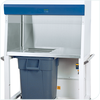What is a PCR cabinet?
A PCR cabinet or PCR workstation is a vertical laminar flow cabinet that is adjusted for the use of PCR equipment. It provides a downflow of filtered air to protect your experiment from cross-contamination with air contaminants. PCR cabinets always have an UV lamp to decontaminate the cabinet from RNA and DNA between 2 PCR cycles.

A PCR cabinet is in principle the same as a vertical laminar flow cabinet, but with a few adjustments:
- Reduced height: when doing PCR, you don’t need a lot of height. In fact, the manipulations around PCR involve mainly pipetting, which is done at work surface height.
- Optimized for quick UV decontamination. UV decontamination is very efficient to destroy RNA and DNA. For that reason, it is useful to have a quick method of activating the UV lamp between 2 PCR cycles. During the UV decontamination, the sash window must be closed to protect the operator. A PCR cabinet has a sash window with hinges that can easily be closed. When the sash window is closed, the UV lamp is automatically activated to start the UV decontamination.
- Electrical sockets and other items that are not resistant to prolonged exposure to UV radiation are not present in PCR cabinets.
- PCR cabinets also typically have a shelf near the UV lamp. Pipettes can be put on the shelf for decontamination.
Both cabinet types have an UV lamp and are optimized for a quick activation of UV decontamination. A PCR cabinet or PCR workstation has a downflow of filtered air, that protects the experiment against cross contamination with the air. A dead air box does not have this. A dead airbox is simply a cabinet with a UV lamp, and does not offer any kind of protection of your experiment from air contaminants when the cabinet is open.









